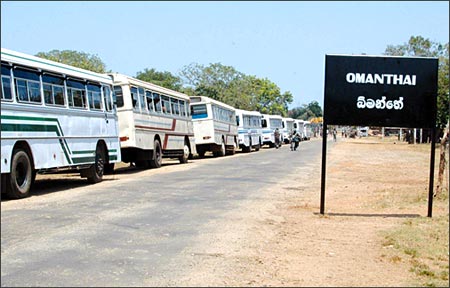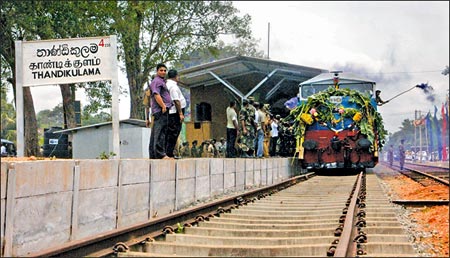True freedom through free journey on A-9
By Ranil WIJAYAPALA
|

A- 9 Road at Omanthai |
The hot air under the scorching April sun blowing into the vehicle
through shutters made our clothes wet in minutes due to sweat pouring
from our bodies. Our vehicle was running fast along the straight road
through the lonely lands in the Northern tip of the country.
Buses and vans were overtaking us as if we were on a race to one
destination with dozens of other vehicles running fast in the opposite
direction.
The A-9, the road which was confined only for military convoys beyond
Vavuniya a year ago has become one of the busiest roads in the country.
Thanks to the great victory we achieved exactly a year ago eliminating
the terror outfit from the soil of Sri Lanka.
Almost after one year of that great victory, I was on board a bus as
an ordinary passenger or rather a pilgrim among thousands of other
citizens in the South visiting Jaffna, setting aside my usual assignment
as a journalist.
What I really wanted was to become a silent observer to feel the true
freedom the country achieved a year ago. Being a frequent traveller
through this route throughout the conflict for my journalistic missions,
I can feel the real freedom we are enjoying today. The ordinary citizen
is no exception.
No travel permit
No travel permits or security clearance letters, either with me or
with the driver to proceed through the A-9 road. Even the busy
Medawachchiya Road block, which stood like a big scanning machine to
prevent terror paws sneaking to the south or to the north is idling
today like an insignificant fortress.
Earlier, not a single vehicle, irrespective of the person who was
travelling in, was allowed to proceed through this point without a
clearance letter from the Ministry of Defence or relevant security
officials.
Even bus services to Vavuniya were discontinued at this point
compelling the commuters to change their bus to reach their destination.
I can still remember people complaining about this checkpoint as a
‘real headache’ but it was the main centre to secure Colombo and the
South.
|

A checkpoint on A - 9 |
Today, the huge concrete slabs erected for the expansion of the
checkpoint at the latter stages of the war, stand like artifacts
recalling the sombre memories of old days. The Irattaperiyakulam
checkpoint which was the gateway to Vavuniya is no exception.
The busy Vavuniya town has taken a new face with the removal of all
barriers and razer wired fences but also with the new addition to the
city with dozens of people from the welfare camps selling their food
collection in the city pavements.
“They have made it a lucrative bushiness to earn their living” a
Policeman who got into our bus to reach Omanthai explained to us.
The workers busy reconstructing the A-9 road and the rail line that
goes parallel to the A-9 road gives the true impression about the
transitional period the people living there is undergoing at this point.
It was a clear signal that the people in the South and the North will
soon have a day to recall and continue their prestine glory embedded
with the stories of amity and peaceful co-existence whilst preserving
the true identities of both Sinhala and Tamil communities.
Yal Devi
The rail track, and ‘Yal Devi’ train, I strongly believe, will soon
be there to expedite the process of reconciliation between the two
communities.
Therefore, those old barriers will soon be removed like the so-called
boundaries we had in Omanthai a few years ago.
Today, the boundary we had in Omanthai has already been added to the
ruins of war apart from a section of buildings of the checkpoint now
operating to register the vehicles to the South.
But I could not stop myself feeling that I was entering a different
land even one year after the great victory since that so-called
boundaries were deeply rooted in our minds.
However, the presence of troops along the road extending their hands
to the people who had restarted their lives back in their villages to
build temporary shelters, helped me to come out of that feeling.
Small boutiques where people selling essential commodities have come
up among the many ‘Jana Avanhal’ (boutiques maintained by the Sri Lanka
Army) along the road to cater to the needs of the troops and the
civilians as well. The Special Task Force and Police were systematically
taking over administration in the areas where civilians have been
resettled.
Replacing the bunkers many permanent structures and houses are coming
up along the road heralding a new era free of terrorism to the people
living there.
Hub of Vanni

The Yal Devi |
The Mankulam junction which is the central hub of the Vanni has
become a busy junction town where hundreds of people stop on their way
to Jaffna, to have refreshments from ‘Jana Avanhala’ and several other
boutiques maintained by civilians.
The road was not in an entirely good condition but in a position to
provide a comparatively comfortable ride for the people in the vehicles.
But it was the enthusiasm of the people to visit this unknown territory
a familiar one which made them to travel along this A-9 road to Jaffna.
The places where the intense battles were fought and the places where
their beloved ones sacrificed their lives for a better tomorrow for the
nation are their prime interests.
It reminded me of the tales of the war heroes who proudly walked
along this route in their thirst to end the war against terrorism under
severe difficulties.
The huge telecommunication tower coming up in Kokavil and the way
debris of the war shattered Kilinochchi town being removed, have become
a realistic task today due to their sacrifices.
The dust of war is being systematically swept from this terrain as
civilians taking their due place in the city in keeping with the ongoing
resettlement process. A crowded fair in the city centre has shifted its
face from a war ravaged city into a city in transition giving a
glittering hope for the resettlers about a brighter future.
Supreme sacrifice
Despite, the scorching sun any citizen passing the Elephant Pass
terrain take the chance of having a respite in their long journey where
they can observe the place where our war hero Hasalaka Gamini made his
supreme sacrifice.
Students along with their teachers also make it a chance to study the
geography of the location with maps in their hands as it may be the
first time they are visiting this narrow isthmus of the island.
The picturesque war monument gives shade of tranquillity to the
travellers along the road and to think what a strategic area it was in
the battles.
They are moving freely as there is no fear of becoming a victim of a
mortar or artillery round of the LTTE. So I also enjoyed that true
freedom recalling the big day in which the troops from the North and the
Wanni embraced each other in this narrow land stretch as they fully
liberated the A-9 road.
The soil soaked with the blood of our valiant troops bear testimony
for the great victory achieved by liberating this land from the ruthless
terrorists for ever.
Gratitude for war heroes
So it was with the feeling of gratitude to our war heroes we passed
the terrain in Iyakachchi, Soranpattu, Pallai and Muhamalai where the
bloodiest battles were fought between the Security Forces and the LTTE.
Even one year after the silencing of guns the terrain could not hide
the wholemarks of those bloody battles as the signs of those Forward
Defences still remains untouched despite they being invaded by thorny
bushes.
The tricky de-mining process which is now on in this terrain will
take more years to get rid of thousands of mines burried there in
Muhamalai.
Freedom of movement has been fully established in Jaffna peninsula
too as there was no need to get down at each and every checkpoint for
security checkings. So there was no need to have our identity cards in
our hands except for an extreme necessity.
The entire Jaffna city was full of southerners and they move freely
along the roads which I had never experienced earlier. Eventhough people
thronged into Jaffna in thousands during the so-called Ceasefire period
they underwent all sorts of harassment at the hands of the LTTE on their
way to Jaffna and also within Jaffna city. The razer blade fences which
were installed not only in the city but also in the sea adjacent to
Gurunagar jetty have been removed giving a sense of true freedom to the
people there.
So there is no restriction for them to move into the Jaffna market
and bargain with the traders when they buy ‘Thal Hakuru’, dry fish or
bags made of palmyra leaves as souvenirs.
The famous Duraiappa Stadium which is located by the side of the
Jaffna town has become the resting place for the pilgrims. And people
are free to have a look at the Jaffna library the pride of the Jaffna
people, without any restriction.
People thronging there in thousands has created many lucrative
business for many people. Provision of resting place and lodging for the
people has become the most lucrative business.
However, the famous Weerasingham Hall in Jaffna gave shelter for
hundreds of other pilgrims awaiting there to visit Nagadeepa the
following days. We were also among them and had a dip after our
exhausting journey throughout the day.
It was in the early hours of following day we started our pilgrim to
Nagadeepa to be among the first few lot of the long queue of vehicles at
Punguduthivu to take our journey to Nagadeepa or Nainathivu island.
The queue was long but the Sri Lanka Navy has put a mechanism in
place to expedite the process of sending the people to Nagadeepa by
boats from the jetty in Pungudutivu.
Sea Tigers
The Navy personnel there were not worried about sudden landing of Sea
Tigers, suicide boats or any other terror attack. Their only concern
today is the convenience of the pilgrims visiting ‘Nagadeepa’ and
provide them a safe journey.
Dozens of boats ferrying the people to and from Nagadeepa were busy
like bees and few dozens of pilgrims packed in boats depart from the
jetty in every five minute to ease the congestion.
Finally, we all were in the boat and get down from the jetty located
close to the historic Nagadeepa temple after few minutes voyage in the
sea.
I felt as if I had come to the climax of my journey as I could fulfil
my long lasted wish in my mind, when I was rushing through the large
number of devotees thronging into the temple.
Not that it was my first visit to ‘Nagadeepa. I had visited this
place several occasions for my journalistic missions, but this time it
was a different visit because for the first time I was with my family
and relatives and friends like an ordinary citizen.
So I was happy as a true citizen of this country to feel the freedom
of travelling along each and every part of this country free of
terrorism.
It was with the hope that this true freedom the country enjoy today
would not be doomed under any circumstances, we began our return journey
towards the South through the same road which brought ultimate freedom
to the country forever. |

